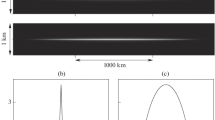A mathematical model is proposed describing the initial phase of solar flare heating in the corona. The model is based on the nonlinear heat equation with a sign-alternating volume source, which is derived from the energy equation of the electron component of stationary plasma. Flares are assumed to arise as a result of sausage-type instabilities of a magnetic tube and creation of collapsing magnetic traps. A source function is chosen and the model parameters are fitted. Thermal structures arising under supercritical perturbations in a homogeneous temperature background are calculated and their specific features are examined. With nonclassical heat conduction, flares produce structures for which the half-width of the energy release region shrinks over time. The effect of “emission measure reduction” observed in the early phase of the flare is associated with the decrease of the flare filling factor due to the decrease of the structure half-width.
Similar content being viewed by others
References
E. Priest and T. Forbes, Magnetic Reconnection: MHD Theory and Applications, Cambridge Univ. Press (2007).
V. A. Kovalev, I. G. Kostyuchenko, M. I. Savchenko, and Yu. E. Charikov, “Plasma heating and “evaporation” regimes during the solar flare of 5 July 2009,” Pulk. Sb. (2010).
I. A. Bilenko and V. A. Kovalev, “Heating regimes during solar flares,” Pis’ma Astron. Zh., 35, 873 (2009).
A. A. Samarskii, V. A. Galaktionov, S. P. Kurdyumov, and A. P. Mikhailov, Blowup Regimes in Problems for Quasilinear Parabolic Equations [in Russian], Nauka, Moscow (1987).
G. G. Malinetskii (editor), Blowup Regimes: Evolution of an Idea [in Russian], Fizmatlit, Moscow (2006).
S. P. Kurdyumov and E. S. Kurkina, “The eigenfunction spectrum of a self-similar problem for nonlinear heat equation with a source,” Zh. Vychisl. Matem. Mat. Fiz., 44, No. 9, 1619–1637 (2004).
E. S. Kurkina, “The spectrum of two-dimensional localized structures evolving with blowup,” Dinamika Slozhnykh Sistem, 1, No. 1, 17-38 (2007).
E. S. Kurkina and I. M. Nikol’skii, “Investigation of a nonlinear heat equation with a quadratic source,” Prkl. Matem. Informat., MGU, No. 24, 5–23 (2006).
V. A. Kovalev and I. V. Kovalev, “Differential method of diagnosing nonlinear regimes,” Nelin. Mir, 7, No. 12, 918–921 (2009).
V. A. Kovalev and B. V. Somov, “The role of collisions for particle acceleration in solar flare magnetic traps,” Pis’ma Astron. Zh., 29, No. 6, 465–472 (2003).
V. A. Kovalev, G. P. Chernov, and I. Hanaoka, “Small-scale high-temperature structures in a flare region,” Pis’ma Astron. Zh., 27, No. 4, 310–320 (2001).
Author information
Authors and Affiliations
Corresponding author
Additional information
Translated from Prikladnaya Matematika i Informatika, No. 45, 2014, pp. 15–31.
Rights and permissions
About this article
Cite this article
Kurkina, E.S., Kuretova, E.D. & Kovalev, V.A. Formation of Thermal Structures with Blowup During Solar Flares. Comput Math Model 26, 144–155 (2015). https://doi.org/10.1007/s10598-015-9262-5
Published:
Issue Date:
DOI: https://doi.org/10.1007/s10598-015-9262-5




